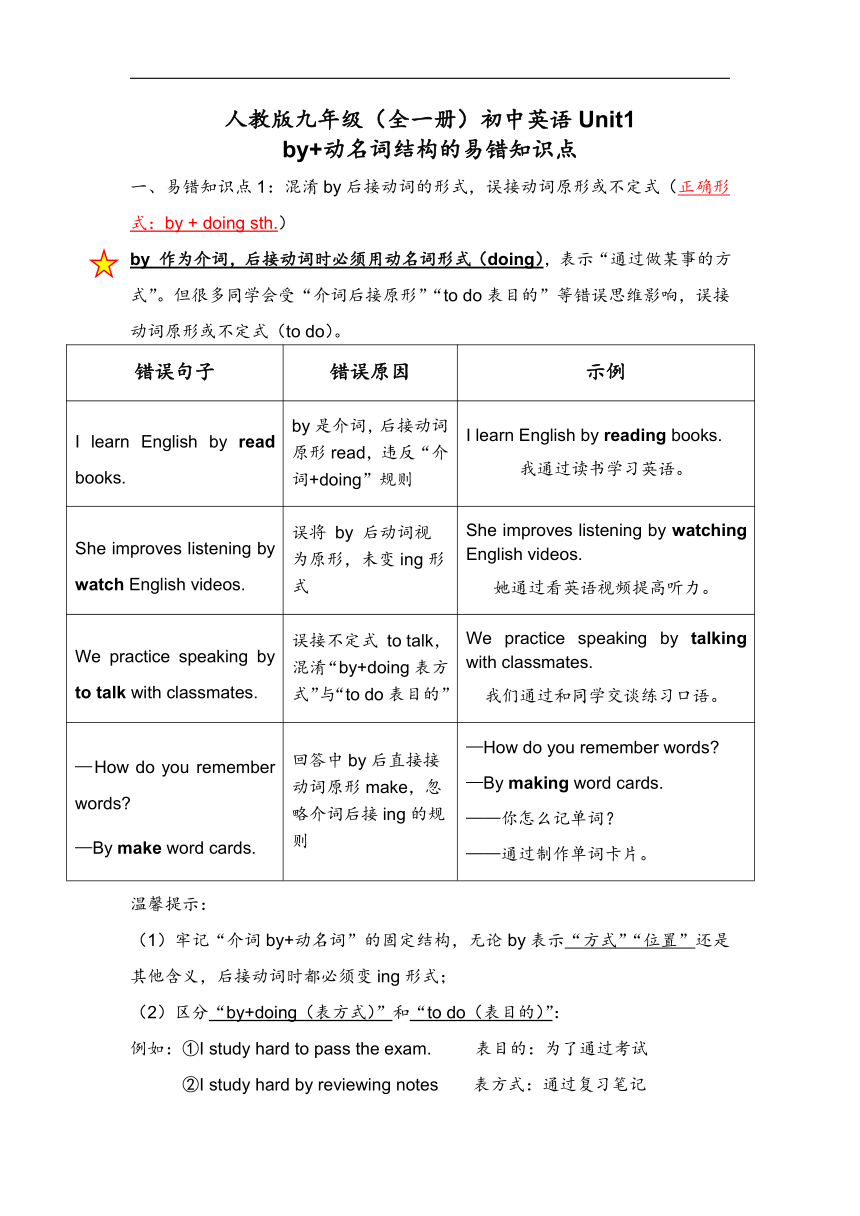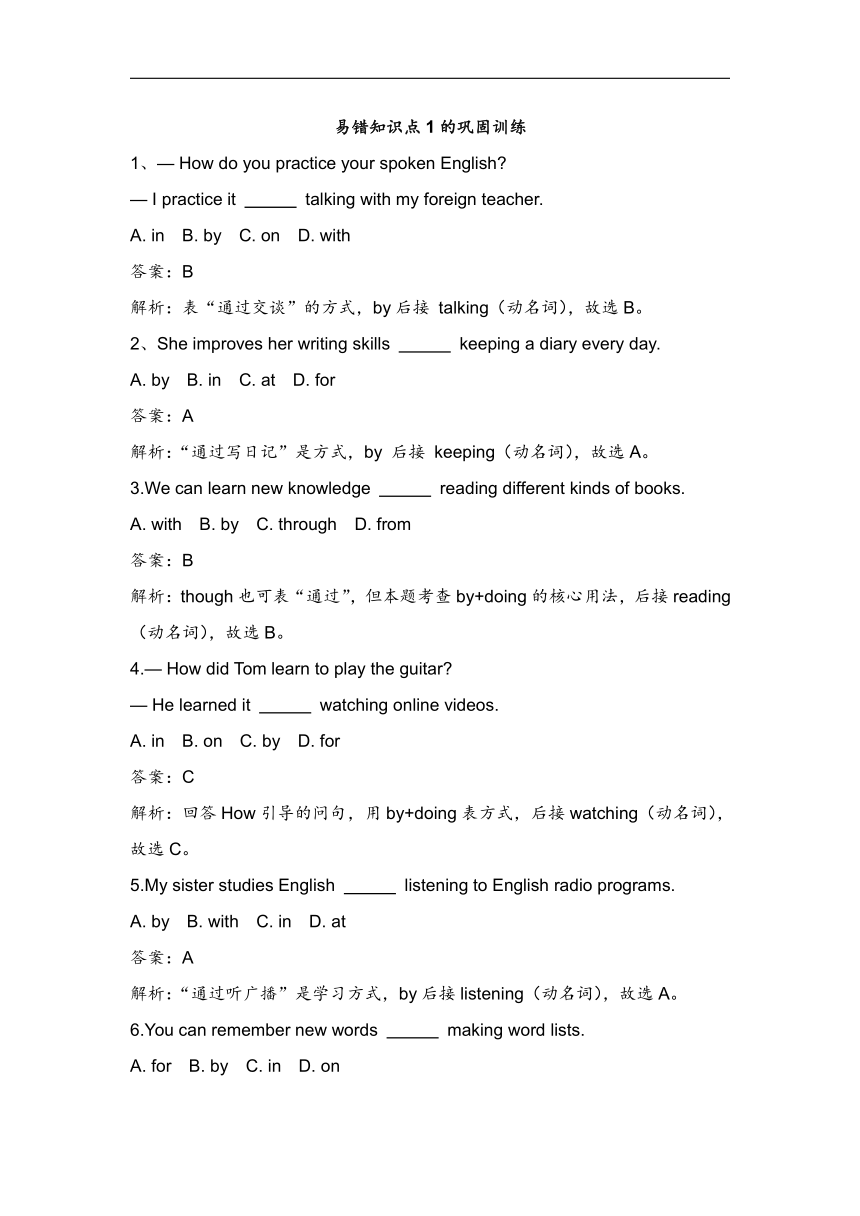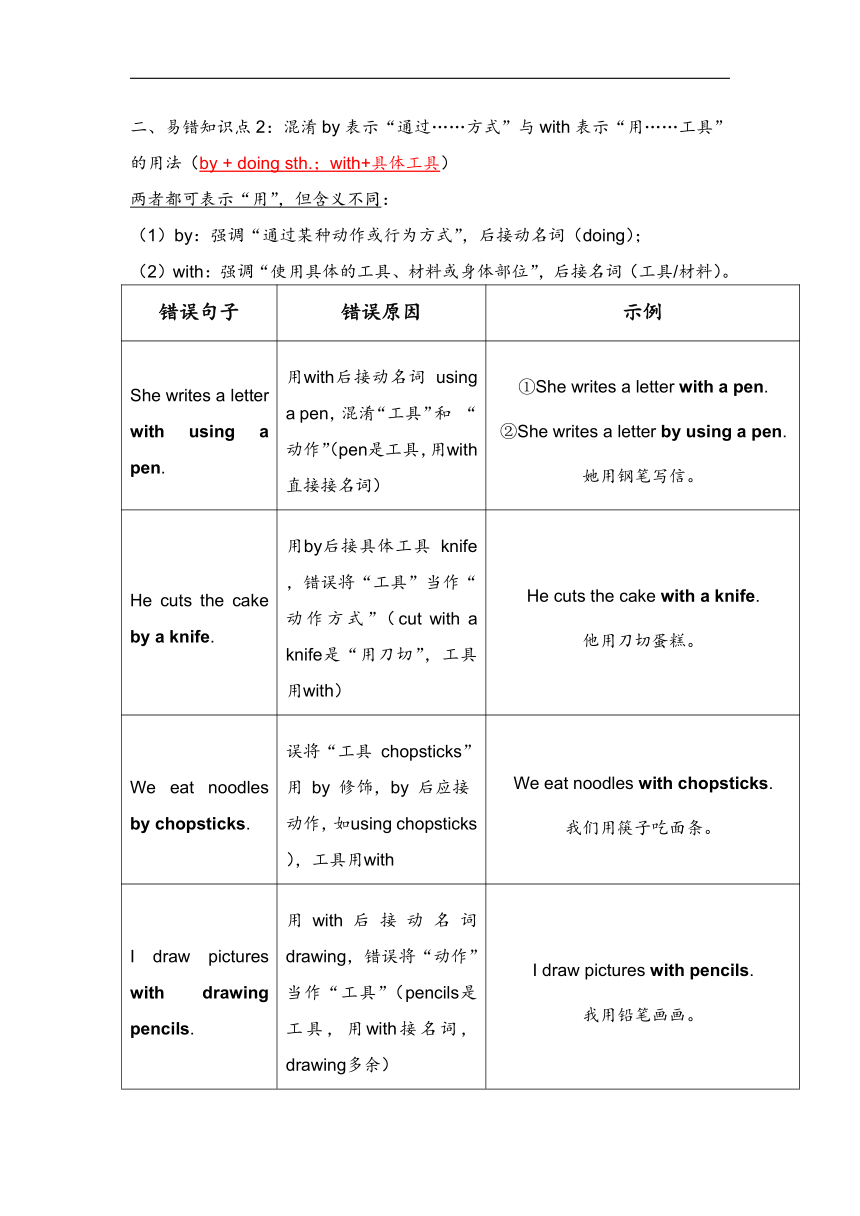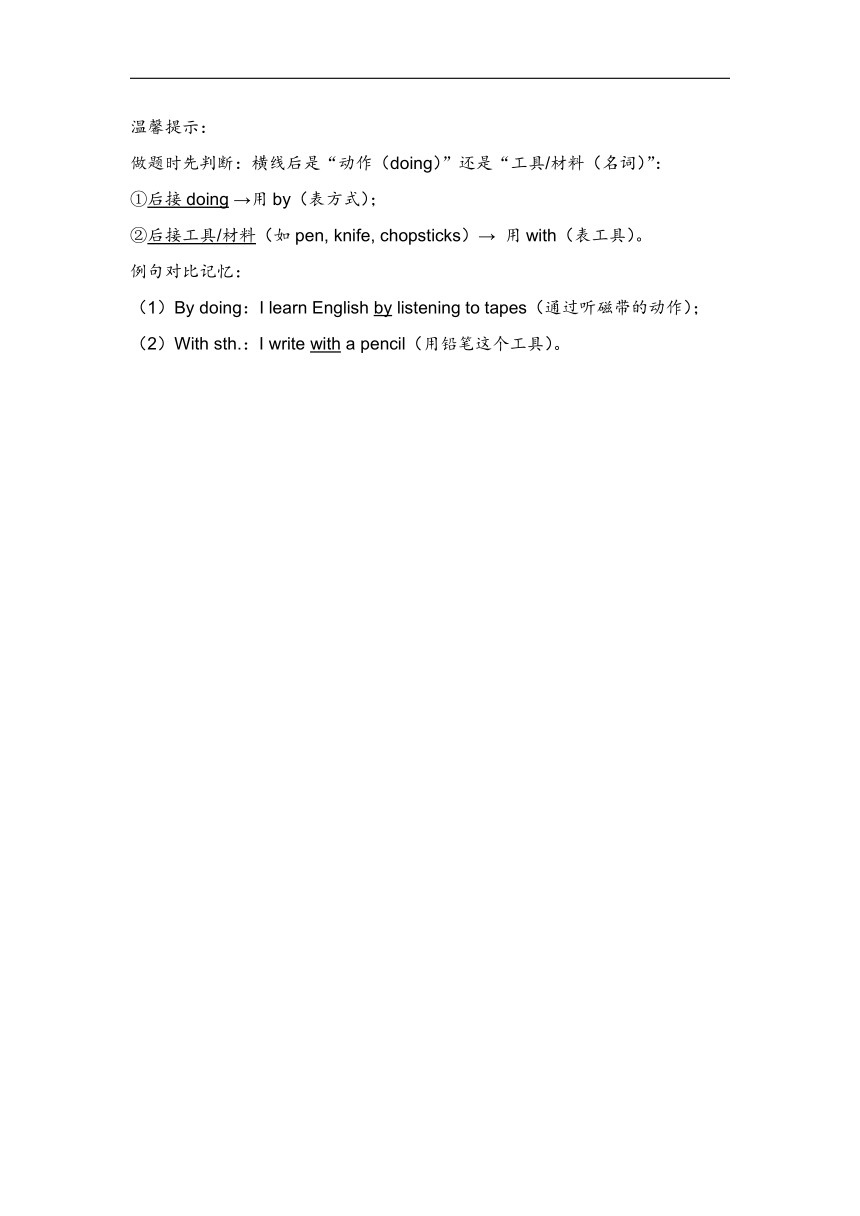Unit 1 How can we become good learners?by动名词结构的易错知识点2025-2026学年人教版英语九年级全册
文档属性
| 名称 | Unit 1 How can we become good learners?by动名词结构的易错知识点2025-2026学年人教版英语九年级全册 |  | |
| 格式 | docx | ||
| 文件大小 | 33.1KB | ||
| 资源类型 | 教案 | ||
| 版本资源 | 人教新目标(Go for it)版 | ||
| 科目 | 英语 | ||
| 更新时间 | 2025-08-28 17:45:16 | ||
图片预览





文档简介
人教版九年级(全一册)初中英语Unit1
by+动名词结构的易错知识点
一、易错知识点1:混淆by后接动词的形式,误接动词原形或不定式(正确形式:by + doing sth.)
by 作为介词,后接动词时必须用动名词形式(doing),表示“通过做某事的方式”。但很多同学会受“介词后接原形”“to do表目的”等错误思维影响,误接动词原形或不定式(to do)。
错误句子 错误原因 示例
I learn English by read books. by是介词,后接动词原形read,违反“介词+doing”规则 I learn English by reading books. 我通过读书学习英语。
She improves listening by watch English videos. 误将 by 后动词视为原形,未变ing形式 She improves listening by watching English videos. 她通过看英语视频提高听力。
We practice speaking by to talk with classmates. 误接不定式 to talk,混淆“by+doing表方式”与“to do表目的” We practice speaking by talking with classmates. 我们通过和同学交谈练习口语。
—How do you remember words —By make word cards. 回答中by后直接接动词原形make,忽略介词后接ing的规则 —How do you remember words —By making word cards. ——你怎么记单词? ——通过制作单词卡片。
温馨提示:
(1)牢记“介词by+动名词”的固定结构,无论by表示“方式”“位置”还是其他含义,后接动词时都必须变ing形式;
(2)区分“by+doing(表方式)”和“to do(表目的)”:
例如:①I study hard to pass the exam. 表目的:为了通过考试
②I study hard by reviewing notes 表方式:通过复习笔记
易错知识点1的巩固训练
1、— How do you practice your spoken English
— I practice it talking with my foreign teacher.
A. in B. by C. on D. with
答案:B
解析:表“通过交谈”的方式,by后接 talking(动名词),故选B。
2、She improves her writing skills keeping a diary every day.
A. by B. in C. at D. for
答案:A
解析:“通过写日记”是方式,by 后接 keeping(动名词),故选A。
3.We can learn new knowledge reading different kinds of books.
A. with B. by C. through D. from
答案:B
解析:though也可表“通过”,但本题考查by+doing的核心用法,后接reading(动名词),故选B。
4.— How did Tom learn to play the guitar
— He learned it watching online videos.
A. in B. on C. by D. for
答案:C
解析:回答How引导的问句,用by+doing表方式,后接watching(动名词),故选C。
5.My sister studies English listening to English radio programs.
A. by B. with C. in D. at
答案:A
解析:“通过听广播”是学习方式,by后接listening(动名词),故选A。
6.You can remember new words making word lists.
A. for B. by C. in D. on
答案:B
解析:“通过制作单词表”是记单词的方式,by后接making(动名词),故选B。
7.They practice playing basketball having training every weekend.
A. by B. with C. from D. to
答案:A
解析:“通过周末训练”是练篮球的方式,by后接having(动名词),故选A。
8、— How do you prepare for the exam
— I prepare for it reviewing all the lessons.
A. in B. by C. at D. with
答案:B
解析:回答考试准备的方式,by后接reviewing(动名词),故选B。
9、He improves his memory playing memory games.
A. by B. for C. in D. on
答案:A
解析:“通过玩记忆游戏”是提高记忆力的方式,by后接playing(动名词),故选A。
10、We can know about the world reading newspapers and magazines.
A. with B. by C. through D. from
答案:B
解析:“通过读报刊”是了解世界的方式,by后接reading(动名词),故选B。
二、易错知识点2:混淆by表示“通过……方式”与with表示“用……工具” 的用法(by + doing sth.;with+具体工具)
两者都可表示“用”,但含义不同:
(1)by:强调“通过某种动作或行为方式”,后接动名词(doing);
(2)with:强调“使用具体的工具、材料或身体部位”,后接名词(工具/材料)。
错误句子 错误原因 示例
She writes a letter with using a pen. 用with后接动名词 using a pen,混淆“工具”和 “动作”(pen是工具,用with直接接名词) ①She writes a letter with a pen. ②She writes a letter by using a pen. 她用钢笔写信。
He cuts the cake by a knife. 用by后接具体工具 knife,错误将“工具”当作“动作方式”(cut with a knife是“用刀切”,工具用with) He cuts the cake with a knife. 他用刀切蛋糕。
We eat noodles by chopsticks. 误将“工具 chopsticks”用 by 修饰,by 后应接动作,如using chopsticks),工具用with We eat noodles with chopsticks. 我们用筷子吃面条。
I draw pictures with drawing pencils. 用with后接动名词 drawing,错误将“动作”当作“工具”(pencils是工具,用with接名词,drawing多余) I draw pictures with pencils. 我用铅笔画画。
温馨提示:
做题时先判断:横线后是“动作(doing)”还是“工具/材料(名词)”:
①后接doing →用by(表方式);
②后接工具/材料(如pen, knife, chopsticks)→ 用with(表工具)。
例句对比记忆:
(1)By doing:I learn English by listening to tapes(通过听磁带的动作);
(2)With sth.:I write with a pencil(用铅笔这个工具)。
易错知识点2的巩固训练
1、He writes letters using a pen.
A. by B. with C. in D. on
答案:A
解析:后接using a pen(动作),表“通过用钢笔的方式”,用by,故选A。
2、She draws pictures a pencil.
A. by B. with C. in D. for
答案:B
解析:后接a pencil(工具),表“用铅笔”,用with,故选B。
3、— How do you cut the paper
— I cut it using a pair of scissors.
A. by B. with C. in D. at
答案:A
解析:后接using a pair of scissors(动作),回答“如何剪纸”的方式,用by,故选A。
4、We eat noodles chopsticks.
A. by B. with C. through D. from
答案:B
解析:后接 chopsticks(工具),表“用筷子”,用 with,故选B。
5、He fixes the bike using a screwdriver.
A. by B. with C. in D. on
答案:A
解析:后接using a screwdriver(动作),表“通过用螺丝刀的方式”,用by,故选 A。
6、She writes her homework a pen.
A. by B. with C. for D. at
答案:B
解析:后接a pen(工具),表“用钢笔写作业”,用with,故选B。
7、— How do you make the model ship
— I make it using wood and glue.
A. by B. with C. in D. from
答案:A
解析:后接 using wood and glue(动作),回答“制作模型船的方式”,用by,故选 A。
8、We cook rice a rice cooker.
A. by B. with C. through D. for
答案:B
解析:后接 a rice cooker(工具),表“用电饭煲”,用with,故选B。
9、He cleans the window using a cloth.
A. by B. with C. in D. on
答案:A
解析:后接using a cloth(动作),表“通过用布擦的方式”,用by,故选A。
10、She takes photos a camera.
A. by B. with C. for D. at
答案:B
解析:后接a camera(工具),表“用相机拍照”,用with,故选B。
三、易错知识点3:误用by表示“在…… 旁边”时的介词搭配,或将by与near 混淆(by强调“紧挨着”,near强调“在附近”,范围更广)
by和near 都可表示“在…… 附近”,但距离差异明显。
(1)by:强调“紧挨着、紧贴着”,距离极近(如“窗边、门边”);
(2)near:强调 “在附近的大范围区域内”,距离相对远(如:“家附近的公园、学校附近的商店”)。
错误句子 错误原因 示例
There is a tree near the window. 误将“紧挨着窗户”的近距离用near(near表 “附近大范围”),窗边应是by There is a tree by the window. 窗户旁边有一棵树。
My school is by the park. 误将“公园附近的学校”(大范围)用by(by表“紧挨着”),学校不可能紧贴公园,用 near My school is near the park. 我的学校在公园附近。
The cat is sitting near the sofa. 若想表达 “猫紧挨着沙发坐”,用near不准确(near表“沙发附近”,可能在茶几旁),应选by The cat is sitting by the sofa. 猫正坐在沙发旁边。
There is a shop by my home. 误将“家附近的商店”(大范围)用by,商店不会紧贴家,用near表 “附近区域” There is a shop near my home. 我家附近有一家商店。
温馨提示:
① 若物体A“几乎贴在物体B上”(如桌子在窗边、人在门边)→用by;
② 若物体A“在物体 B 的周边区域,但不紧贴”(如学校在公园附近、商店在家附近)→用near。
结合生活常识:“by the river(河边,紧挨着河)”;“near the city(城市附近,大范围)”。
易错知识点3的巩固训练
1、There is a small shop the school gate.
A. by B. near C. in D. on
答案:A
解析:“学校门口旁边”强调紧挨着校门,用by,故选A。
2、My home is the park, so I often go there for a walk.
A. by B. near C. in D. at
答案:B
解析:“家在公园附近”是大范围,不紧贴公园,用near,故选B。
3、The cat is sitting the sofa.
A. by B. near C. in D. on
答案:A
解析:“猫坐在沙发旁边”强调紧挨着沙发,用by,故选A。
4、There is a bank my home, so it's convenient for me to deposit money.
A. by B. near C. in D. at
答案:B
解析:“家附近的银行”是大范围,不紧贴家,用near,故选B。
5、He is standing the door, waiting for his mother.
A. by B. near C. in D. on
答案:A
解析:“站在门旁边”强调紧挨着门,用by,故选A。
6、The bookstore is the post office, so you can find it easily.
A. by B. near C. in D. for
答案:A
解析:“书店在邮局旁边”强调两者紧挨着(相邻),用by,故选A。
7、There are some trees the road.
A. by B. near C. in D. on
答案:A
解析:“路边的树”强调紧挨着道路,用by,故选A。
8、My uncle's house is the lake, and we can enjoy the beautiful view every day.
A. by B. near C. in D. at
答案:A
解析:“湖边的房子”强调紧挨着湖边(能直接看风景),用by,故选A。
9、There is a pay phone the supermarket.
A. by B. near C. in D. on
答案:B
解析:“超市附近的公用电话”是大范围,不一定紧挨着超市,用near,故选B。
10、The little boy is playing his father.
A. by B. near C. with D. at
答案:C
解析:“和爸爸一起玩”是固定搭配 play with sb.,by和near表位置,不符合 “一起玩”的语境,故选C。
四、易错知识点4:混淆by表示“到…… 为止”与until的用法(by后接时间点,强调“不迟于”;until后接时间点/时间段,强调“持续到……”)
两者都与时间相关,但侧重点不同:
(1)by:后接时间点(如9 o'clock, Friday),强调“不迟于这个时间点完成动作”,动作是短暂性的(如finish, hand in);
(2)until:后接时间点或时间段(如10 p.m., two hours),强调“动作持续到这个时间点才停止”,动作是延续性的(如stay, wait, work)。
同学们常混淆“短暂性动作”和 “延续性动作”,或误将by用于“持续动作”。
错误句子 错误原因 示例
I will finish homework until 8 p.m. “finish(完成)”是短暂性动作,不能“持续到8点”,应用by表“不迟于8点完成” I will finish homework by 8 p.m. 我会在晚上8点之前完成作业。
He stayed in the library by 9 p.m. “stay(停留)”是延续性动作,不能用by表“不迟于9点”,应用until表“持续到9点” He stayed in the library until 9 p.m. 他在图书馆待到了晚上9点。
We have to hand in the paper until tomorrow morning. “hand in(上交)” 是短暂性动作,用until错误,应用by表“不迟于明天早上上交” We have to hand in the paper by tomorrow morning. 我们必须在明天早上之前交卷。
The meeting lasted by 3 o'clock. “last(持续)” 是延续性动作,用by错误,应用until表“持续到3点” The meeting lasted until 3 o'clock. 会议持续到3点。
温馨提示:
用“动作类型判断法”区分:
①动作是“一次性完成”(如finish, hand in, return, send)→短暂性动作→用by+时间点;
②动作是“持续一段时间”(如 stay, wait, work, study, last)→延续性动作→用until+时间点/时间段。
特殊结构记忆:“not...until...”(直到……才……),仅用于until,如“He didn't go to bed until 11 p.m.(他直到11点才睡觉)”,不可用by替换。
易错知识点4的巩固训练
1、You must return the magazine the end of this month.
A. by B. until C. in D. on
答案:A
解析:“return(归还)”是短暂性动作,表“不迟于月底归还”,用by,故选A。
2、He will stay in Beijing next Friday.
A. by B. until C. at D. for
答案:B
解析:“stay(停留)”是延续性动作,表“持续待到下周五”,用until,故选B。
3、We need to finish the project 5 p.m. today.
A. by B. until C. in D. on
答案:A
解析:“finish(完成)”是短暂性动作,表“不迟于下午 5 点完成”,用by,故选A。
4、The shop is open 9 p.m. every day, so we can go there after work.
A. by B. until C. at D. for
答案:B
解析:“be open(营业)”是延续性状态,表“持续营业到晚上9点”,用until,故选B。
5、Please send the report to me tomorrow morning.
A. by B. until C. in D. on
答案:A
解析:“send(发送)”是短暂性动作,表“不迟于明天早上发送”,用by,故选A。
6、They waited for the bus 30 minutes, but it still didn't come.
A. by B. until C. for D. in
答案:C
解析:“wait(等待)”是延续性动作,后接“30 minutes(时间段)”,表“等待了30分钟”,用for,故选C。
7、The meeting will last 4 o'clock this afternoon.
A. by B. until C. at D. on
答案:B
解析:“last(持续)”是延续性动作,表“持续到下午4点”,用until,故选B。
8、You have to hand in your paper the teacher leaves the classroom.
A. by B. until C. before D. after
答案:A
解析:“hand in(上交)”是短暂性动作,表“不迟于老师离开前上交”,用by,故选A。
9、The rain didn't stop midnight, so we had to cancel the outdoor activity.
A. by B. until C. at D. for
答案:B
解析:“stop(停止)”是短暂性动作,但此处用“not...until...”结构,表“直到午夜才停”,用until,故选B。
10、We should complete the task the end of this week.
A. by B. until C. in D. on
答案:A
解析:“complete(完成)”是短暂性动作,表“不迟于本周末完成”,用by,故选A。
by+动名词结构的易错知识点
一、易错知识点1:混淆by后接动词的形式,误接动词原形或不定式(正确形式:by + doing sth.)
by 作为介词,后接动词时必须用动名词形式(doing),表示“通过做某事的方式”。但很多同学会受“介词后接原形”“to do表目的”等错误思维影响,误接动词原形或不定式(to do)。
错误句子 错误原因 示例
I learn English by read books. by是介词,后接动词原形read,违反“介词+doing”规则 I learn English by reading books. 我通过读书学习英语。
She improves listening by watch English videos. 误将 by 后动词视为原形,未变ing形式 She improves listening by watching English videos. 她通过看英语视频提高听力。
We practice speaking by to talk with classmates. 误接不定式 to talk,混淆“by+doing表方式”与“to do表目的” We practice speaking by talking with classmates. 我们通过和同学交谈练习口语。
—How do you remember words —By make word cards. 回答中by后直接接动词原形make,忽略介词后接ing的规则 —How do you remember words —By making word cards. ——你怎么记单词? ——通过制作单词卡片。
温馨提示:
(1)牢记“介词by+动名词”的固定结构,无论by表示“方式”“位置”还是其他含义,后接动词时都必须变ing形式;
(2)区分“by+doing(表方式)”和“to do(表目的)”:
例如:①I study hard to pass the exam. 表目的:为了通过考试
②I study hard by reviewing notes 表方式:通过复习笔记
易错知识点1的巩固训练
1、— How do you practice your spoken English
— I practice it talking with my foreign teacher.
A. in B. by C. on D. with
答案:B
解析:表“通过交谈”的方式,by后接 talking(动名词),故选B。
2、She improves her writing skills keeping a diary every day.
A. by B. in C. at D. for
答案:A
解析:“通过写日记”是方式,by 后接 keeping(动名词),故选A。
3.We can learn new knowledge reading different kinds of books.
A. with B. by C. through D. from
答案:B
解析:though也可表“通过”,但本题考查by+doing的核心用法,后接reading(动名词),故选B。
4.— How did Tom learn to play the guitar
— He learned it watching online videos.
A. in B. on C. by D. for
答案:C
解析:回答How引导的问句,用by+doing表方式,后接watching(动名词),故选C。
5.My sister studies English listening to English radio programs.
A. by B. with C. in D. at
答案:A
解析:“通过听广播”是学习方式,by后接listening(动名词),故选A。
6.You can remember new words making word lists.
A. for B. by C. in D. on
答案:B
解析:“通过制作单词表”是记单词的方式,by后接making(动名词),故选B。
7.They practice playing basketball having training every weekend.
A. by B. with C. from D. to
答案:A
解析:“通过周末训练”是练篮球的方式,by后接having(动名词),故选A。
8、— How do you prepare for the exam
— I prepare for it reviewing all the lessons.
A. in B. by C. at D. with
答案:B
解析:回答考试准备的方式,by后接reviewing(动名词),故选B。
9、He improves his memory playing memory games.
A. by B. for C. in D. on
答案:A
解析:“通过玩记忆游戏”是提高记忆力的方式,by后接playing(动名词),故选A。
10、We can know about the world reading newspapers and magazines.
A. with B. by C. through D. from
答案:B
解析:“通过读报刊”是了解世界的方式,by后接reading(动名词),故选B。
二、易错知识点2:混淆by表示“通过……方式”与with表示“用……工具” 的用法(by + doing sth.;with+具体工具)
两者都可表示“用”,但含义不同:
(1)by:强调“通过某种动作或行为方式”,后接动名词(doing);
(2)with:强调“使用具体的工具、材料或身体部位”,后接名词(工具/材料)。
错误句子 错误原因 示例
She writes a letter with using a pen. 用with后接动名词 using a pen,混淆“工具”和 “动作”(pen是工具,用with直接接名词) ①She writes a letter with a pen. ②She writes a letter by using a pen. 她用钢笔写信。
He cuts the cake by a knife. 用by后接具体工具 knife,错误将“工具”当作“动作方式”(cut with a knife是“用刀切”,工具用with) He cuts the cake with a knife. 他用刀切蛋糕。
We eat noodles by chopsticks. 误将“工具 chopsticks”用 by 修饰,by 后应接动作,如using chopsticks),工具用with We eat noodles with chopsticks. 我们用筷子吃面条。
I draw pictures with drawing pencils. 用with后接动名词 drawing,错误将“动作”当作“工具”(pencils是工具,用with接名词,drawing多余) I draw pictures with pencils. 我用铅笔画画。
温馨提示:
做题时先判断:横线后是“动作(doing)”还是“工具/材料(名词)”:
①后接doing →用by(表方式);
②后接工具/材料(如pen, knife, chopsticks)→ 用with(表工具)。
例句对比记忆:
(1)By doing:I learn English by listening to tapes(通过听磁带的动作);
(2)With sth.:I write with a pencil(用铅笔这个工具)。
易错知识点2的巩固训练
1、He writes letters using a pen.
A. by B. with C. in D. on
答案:A
解析:后接using a pen(动作),表“通过用钢笔的方式”,用by,故选A。
2、She draws pictures a pencil.
A. by B. with C. in D. for
答案:B
解析:后接a pencil(工具),表“用铅笔”,用with,故选B。
3、— How do you cut the paper
— I cut it using a pair of scissors.
A. by B. with C. in D. at
答案:A
解析:后接using a pair of scissors(动作),回答“如何剪纸”的方式,用by,故选A。
4、We eat noodles chopsticks.
A. by B. with C. through D. from
答案:B
解析:后接 chopsticks(工具),表“用筷子”,用 with,故选B。
5、He fixes the bike using a screwdriver.
A. by B. with C. in D. on
答案:A
解析:后接using a screwdriver(动作),表“通过用螺丝刀的方式”,用by,故选 A。
6、She writes her homework a pen.
A. by B. with C. for D. at
答案:B
解析:后接a pen(工具),表“用钢笔写作业”,用with,故选B。
7、— How do you make the model ship
— I make it using wood and glue.
A. by B. with C. in D. from
答案:A
解析:后接 using wood and glue(动作),回答“制作模型船的方式”,用by,故选 A。
8、We cook rice a rice cooker.
A. by B. with C. through D. for
答案:B
解析:后接 a rice cooker(工具),表“用电饭煲”,用with,故选B。
9、He cleans the window using a cloth.
A. by B. with C. in D. on
答案:A
解析:后接using a cloth(动作),表“通过用布擦的方式”,用by,故选A。
10、She takes photos a camera.
A. by B. with C. for D. at
答案:B
解析:后接a camera(工具),表“用相机拍照”,用with,故选B。
三、易错知识点3:误用by表示“在…… 旁边”时的介词搭配,或将by与near 混淆(by强调“紧挨着”,near强调“在附近”,范围更广)
by和near 都可表示“在…… 附近”,但距离差异明显。
(1)by:强调“紧挨着、紧贴着”,距离极近(如“窗边、门边”);
(2)near:强调 “在附近的大范围区域内”,距离相对远(如:“家附近的公园、学校附近的商店”)。
错误句子 错误原因 示例
There is a tree near the window. 误将“紧挨着窗户”的近距离用near(near表 “附近大范围”),窗边应是by There is a tree by the window. 窗户旁边有一棵树。
My school is by the park. 误将“公园附近的学校”(大范围)用by(by表“紧挨着”),学校不可能紧贴公园,用 near My school is near the park. 我的学校在公园附近。
The cat is sitting near the sofa. 若想表达 “猫紧挨着沙发坐”,用near不准确(near表“沙发附近”,可能在茶几旁),应选by The cat is sitting by the sofa. 猫正坐在沙发旁边。
There is a shop by my home. 误将“家附近的商店”(大范围)用by,商店不会紧贴家,用near表 “附近区域” There is a shop near my home. 我家附近有一家商店。
温馨提示:
① 若物体A“几乎贴在物体B上”(如桌子在窗边、人在门边)→用by;
② 若物体A“在物体 B 的周边区域,但不紧贴”(如学校在公园附近、商店在家附近)→用near。
结合生活常识:“by the river(河边,紧挨着河)”;“near the city(城市附近,大范围)”。
易错知识点3的巩固训练
1、There is a small shop the school gate.
A. by B. near C. in D. on
答案:A
解析:“学校门口旁边”强调紧挨着校门,用by,故选A。
2、My home is the park, so I often go there for a walk.
A. by B. near C. in D. at
答案:B
解析:“家在公园附近”是大范围,不紧贴公园,用near,故选B。
3、The cat is sitting the sofa.
A. by B. near C. in D. on
答案:A
解析:“猫坐在沙发旁边”强调紧挨着沙发,用by,故选A。
4、There is a bank my home, so it's convenient for me to deposit money.
A. by B. near C. in D. at
答案:B
解析:“家附近的银行”是大范围,不紧贴家,用near,故选B。
5、He is standing the door, waiting for his mother.
A. by B. near C. in D. on
答案:A
解析:“站在门旁边”强调紧挨着门,用by,故选A。
6、The bookstore is the post office, so you can find it easily.
A. by B. near C. in D. for
答案:A
解析:“书店在邮局旁边”强调两者紧挨着(相邻),用by,故选A。
7、There are some trees the road.
A. by B. near C. in D. on
答案:A
解析:“路边的树”强调紧挨着道路,用by,故选A。
8、My uncle's house is the lake, and we can enjoy the beautiful view every day.
A. by B. near C. in D. at
答案:A
解析:“湖边的房子”强调紧挨着湖边(能直接看风景),用by,故选A。
9、There is a pay phone the supermarket.
A. by B. near C. in D. on
答案:B
解析:“超市附近的公用电话”是大范围,不一定紧挨着超市,用near,故选B。
10、The little boy is playing his father.
A. by B. near C. with D. at
答案:C
解析:“和爸爸一起玩”是固定搭配 play with sb.,by和near表位置,不符合 “一起玩”的语境,故选C。
四、易错知识点4:混淆by表示“到…… 为止”与until的用法(by后接时间点,强调“不迟于”;until后接时间点/时间段,强调“持续到……”)
两者都与时间相关,但侧重点不同:
(1)by:后接时间点(如9 o'clock, Friday),强调“不迟于这个时间点完成动作”,动作是短暂性的(如finish, hand in);
(2)until:后接时间点或时间段(如10 p.m., two hours),强调“动作持续到这个时间点才停止”,动作是延续性的(如stay, wait, work)。
同学们常混淆“短暂性动作”和 “延续性动作”,或误将by用于“持续动作”。
错误句子 错误原因 示例
I will finish homework until 8 p.m. “finish(完成)”是短暂性动作,不能“持续到8点”,应用by表“不迟于8点完成” I will finish homework by 8 p.m. 我会在晚上8点之前完成作业。
He stayed in the library by 9 p.m. “stay(停留)”是延续性动作,不能用by表“不迟于9点”,应用until表“持续到9点” He stayed in the library until 9 p.m. 他在图书馆待到了晚上9点。
We have to hand in the paper until tomorrow morning. “hand in(上交)” 是短暂性动作,用until错误,应用by表“不迟于明天早上上交” We have to hand in the paper by tomorrow morning. 我们必须在明天早上之前交卷。
The meeting lasted by 3 o'clock. “last(持续)” 是延续性动作,用by错误,应用until表“持续到3点” The meeting lasted until 3 o'clock. 会议持续到3点。
温馨提示:
用“动作类型判断法”区分:
①动作是“一次性完成”(如finish, hand in, return, send)→短暂性动作→用by+时间点;
②动作是“持续一段时间”(如 stay, wait, work, study, last)→延续性动作→用until+时间点/时间段。
特殊结构记忆:“not...until...”(直到……才……),仅用于until,如“He didn't go to bed until 11 p.m.(他直到11点才睡觉)”,不可用by替换。
易错知识点4的巩固训练
1、You must return the magazine the end of this month.
A. by B. until C. in D. on
答案:A
解析:“return(归还)”是短暂性动作,表“不迟于月底归还”,用by,故选A。
2、He will stay in Beijing next Friday.
A. by B. until C. at D. for
答案:B
解析:“stay(停留)”是延续性动作,表“持续待到下周五”,用until,故选B。
3、We need to finish the project 5 p.m. today.
A. by B. until C. in D. on
答案:A
解析:“finish(完成)”是短暂性动作,表“不迟于下午 5 点完成”,用by,故选A。
4、The shop is open 9 p.m. every day, so we can go there after work.
A. by B. until C. at D. for
答案:B
解析:“be open(营业)”是延续性状态,表“持续营业到晚上9点”,用until,故选B。
5、Please send the report to me tomorrow morning.
A. by B. until C. in D. on
答案:A
解析:“send(发送)”是短暂性动作,表“不迟于明天早上发送”,用by,故选A。
6、They waited for the bus 30 minutes, but it still didn't come.
A. by B. until C. for D. in
答案:C
解析:“wait(等待)”是延续性动作,后接“30 minutes(时间段)”,表“等待了30分钟”,用for,故选C。
7、The meeting will last 4 o'clock this afternoon.
A. by B. until C. at D. on
答案:B
解析:“last(持续)”是延续性动作,表“持续到下午4点”,用until,故选B。
8、You have to hand in your paper the teacher leaves the classroom.
A. by B. until C. before D. after
答案:A
解析:“hand in(上交)”是短暂性动作,表“不迟于老师离开前上交”,用by,故选A。
9、The rain didn't stop midnight, so we had to cancel the outdoor activity.
A. by B. until C. at D. for
答案:B
解析:“stop(停止)”是短暂性动作,但此处用“not...until...”结构,表“直到午夜才停”,用until,故选B。
10、We should complete the task the end of this week.
A. by B. until C. in D. on
答案:A
解析:“complete(完成)”是短暂性动作,表“不迟于本周末完成”,用by,故选A。
同课章节目录
- Unit 1 How can we become good learners.
- Section A
- Section B
- Unit 2 I think that mooncakes are delicious!
- Section A
- Section B
- Unit 3 Could you please tell me where the restroom
- Section A
- Section B
- Unit 4 I used to be afraid of the dark.
- Section A
- Section B
- Unit 5 What are the shirts made of?
- Section A
- Section B
- Review of Units 1-5
- Unit 6 When was it invented?
- Section A
- Section B
- Unit 7 Teenagers should be allowed to choose their
- Section A
- Section B
- Unit 8 It must belong to Carla.
- Section A
- Section B
- Unit 9 I like music that I can dance to.
- Section A
- Section B
- Unit 10 You're supposed to shake hands.
- Section A
- Section B
- Review of Units 6-10
- Unit 11 Sad movies make me cry.
- Section A
- Section B
- Unit 12 Life is full of the unexpected
- Section A
- Section B
- Unit 13 We're trying to save the earth!
- Section A
- Section B
- Unit 14 I remember meeting all of you in Grade 7.
- Section A
- Section B
- Review of Units 11-14
